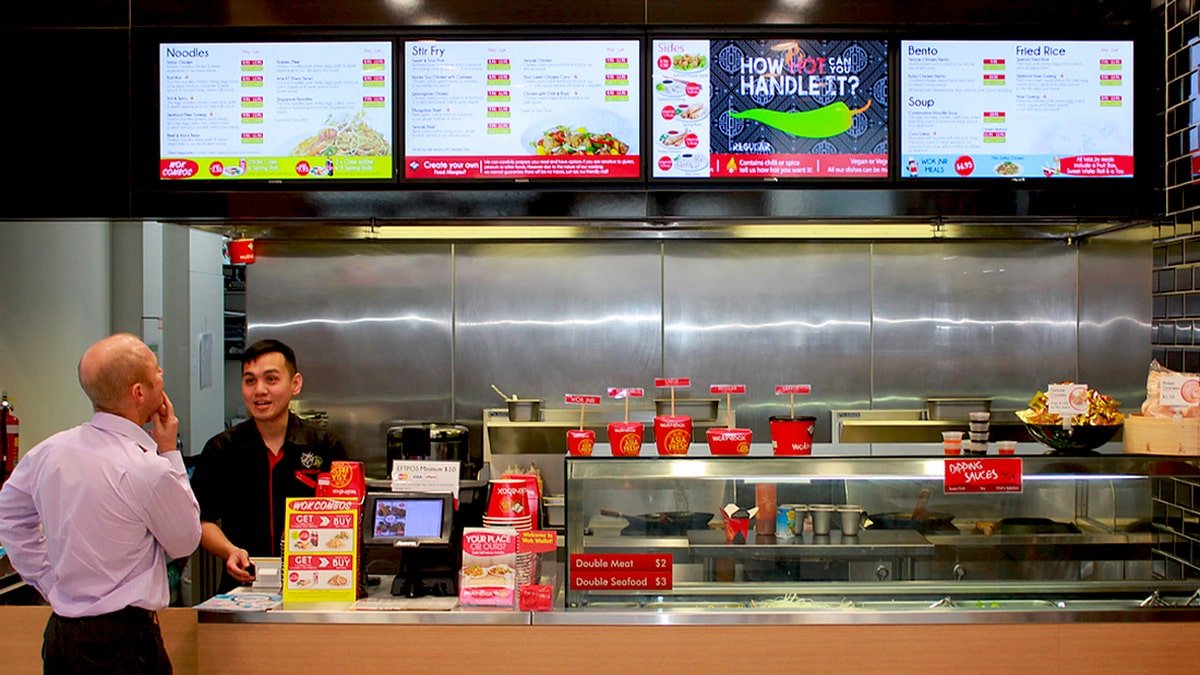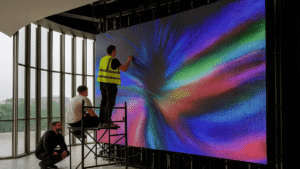Restaurants and retail businesses constantly face the challenge of maximizing customer engagement while keeping costs under control. For decades, static boards were the go-to solution for menus and promotional content. However, the rise of digital technology has paved the way for more dynamic solutions, most notably digital menu boards. The debate of Digital menu boards vs static boards has become central to decision-makers looking for a stronger return on investment (ROI).
In this article, we will conduct a comprehensive ROI comparison between static boards and digital menu boards, examining upfront costs, operational efficiency, customer engagement, revenue impact, and long-term value.
Understanding Static Boards
Static boards, often printed menus or posters, are traditional marketing tools. They are relatively inexpensive to produce, easy to replace, and straightforward in design. Businesses with tight budgets often gravitate toward static boards because the upfront cost is lower compared to digital solutions.
However, static boards come with limitations. Updating content requires reprinting, which can be costly over time. They also lack the flexibility to display dynamic promotions, time-sensitive offers, or videos that could capture customers’ attention more effectively.
Understanding Digital Menu Boards
Digital menu boards are digital screens powered by a content management system (CMS). They allow real-time updates, integrate animations, showcase videos, and adapt content based on time of day, season, or even customer demographics. Restaurants, cafes, and fast-food chains increasingly adopt digital menu boards to boost customer engagement and streamline operations.
The real debate of Digital menu boards vs static boards revolves around ROI. While digital boards require a higher upfront investment, they offer versatility and long-term cost savings through reduced printing and increased sales.
 Cost Analysis: Initial Investment
Cost Analysis: Initial Investment
The initial cost difference between static and digital boards is significant. Static boards typically cost between $100 and $500, depending on size and materials. In contrast, a single digital menu board setup can range from $1,000 to $3,500, including the screen, mounting, and CMS software.
At first glance, static boards seem more economical. But initial investment is only one piece of the ROI puzzle. Over time, businesses often find that digital boards reduce recurring costs such as design, printing, and shipping, making them more cost-efficient in the long run.
Operational Efficiency and Updates
One of the most compelling advantages of digital boards is operational efficiency. Updating a static board requires printing new material, scheduling installation, and discarding old signage. This process consumes both time and resources.
With digital menu boards, updates can be made in minutes through a CMS dashboard. Businesses can instantly change prices, highlight promotions, or adjust offerings based on inventory. In the comparison of Digital menu boards vs static boards, digital options clearly save both time and recurring costs.
Customer Engagement and Psychology
Digital signage leverages visuals, motion, and interactivity to influence customer behavior. Studies show that digital displays can increase sales by 20–30% through upselling strategies and attention-grabbing content.
Static boards, while reliable, are less engaging. They cannot adapt in real time, nor can they showcase animations or videos. As a result, customer dwell time and attention are limited.
A great example of enhanced engagement is Harnessing the Power of Window Display Signage. Just like digital menu boards, window displays rely on dynamic content to capture attention. When comparing Digital menu boards vs static boards, it becomes evident that customers are more likely to respond to interactive and eye-catching displays.
Revenue Growth Potential
The ROI comparison wouldn’t be complete without examining revenue impact. Digital boards allow for upselling and cross-selling in ways static boards cannot. For example, a digital menu can highlight combo deals during lunchtime or showcase premium items in the evening. This adaptability leads to higher average order values.
Static boards, by contrast, are static in nature. Once printed, they cannot respond to changing customer behaviors or market trends without costly reprints.
Flexibility in Promotions
Digital menu boards provide unmatched flexibility. Businesses can run time-sensitive promotions, seasonal campaigns, or loyalty offers. Content can also be tailored based on location or audience. For example, a coffee shop can promote iced drinks on a hot afternoon and switch to warm beverages during colder evenings—all at the click of a button.
Static boards cannot provide this adaptability. Once installed, the messaging remains the same until the next reprint.
This flexibility also ties into The Benefits of Implementing Touchscreen Information, where interactive displays guide customers through personalized options. While static boards remain fixed, digital menu boards can evolve into interactive tools that enhance the customer journey.
Long-Term Cost Efficiency
Over time, the recurring cost of static boards adds up. Each seasonal change, product launch, or price update requires new printing. For multi-location businesses, these costs multiply significantly.
Digital boards eliminate recurring print costs. While electricity and maintenance are ongoing expenses, they are outweighed by savings from not needing constant reprints. Over three to five years, businesses typically see a substantial return.
In addition, using a Digital Display Buying Guide can help businesses choose the right hardware and software, ensuring long-term durability and efficiency.
Brand Perception and Modernization
Consumers today expect modern, tech-driven experiences. Digital menu boards convey professionalism, innovation, and a forward-thinking brand identity. Customers often perceive restaurants with digital signage as more trustworthy and high-quality.
On the other hand, static boards may come across as outdated, especially in industries where innovation drives customer expectations.
The comparison of Digital menu boards vs static boards shows that beyond ROI, digital signage positively influences brand perception.
 Environmental Impact
Environmental Impact
Sustainability is a growing concern for businesses. Static boards contribute to paper waste, ink usage, and transportation emissions from frequent reprints. Digital boards, though requiring electricity, eliminate the environmental cost of disposable signage.
Businesses prioritizing green initiatives often find digital signage aligns better with their sustainability goals.
Case Study: Restaurants
Quick-service restaurants (QSRs) illustrate the ROI difference well. Many QSRs adopting digital menu boards report sales increases of up to 25% within the first year. Dynamic content helps highlight profitable items, adjust menus in real time, and promote limited-time offers effectively.
In fact, many QSRs find digital solutions to be the best digital signage system for restaurants, combining operational efficiency, visual appeal, and sales impact.
Case Study: Retail Environments
Retailers also benefit significantly from digital signage. A clothing store, for instance, can promote seasonal discounts instantly without waiting for printed posters. Dynamic promotions drive impulse purchases and align with customer expectations of fast-changing retail environments.
This is another clear example of why the ROI of digital boards surpasses that of static boards.
Risks and Considerations
While the benefits of digital menu boards are clear, businesses must also consider potential drawbacks:
- Upfront cost: Higher than static boards.
- Maintenance: Requires occasional technical support.
- Power consumption: Though not significant, it is an ongoing cost.
- Training: Staff must learn to use the CMS.
Despite these challenges, the long-term benefits usually outweigh the risks.
ROI Calculation Example
Imagine a restaurant that spends $1,200 annually on printing and shipping static menus. Switching to a $3,000 digital menu board system eliminates those costs. If the restaurant also experiences a 10% sales increase from upselling (an additional $20,000 annually), the ROI becomes clear:
- Year 1: $20,000 (sales boost) – $3,000 (investment) = $17,000 gain.
- Year 2: $20,000 (sales boost) – $0 (new investment) = $20,000 gain.
In contrast, static boards never directly drive sales growth and continue to generate recurring costs
Conclusion
The comparison of Digital menu boards vs static boards highlights a clear winner for long-term ROI. While static boards are cheaper upfront, digital menu boards offer dynamic content, customer engagement, operational efficiency, and long-term savings that outweigh the initial cost.
Businesses seeking modernization, sustainability, and improved revenue will find that digital menu boards provide unmatched advantages.
When evaluating Digital menu boards vs static boards, decision-makers should consider not only the financial ROI but also the customer experience, branding impact, and future scalability. As consumer expectations evolve, digital signage will remain the smarter investment.




